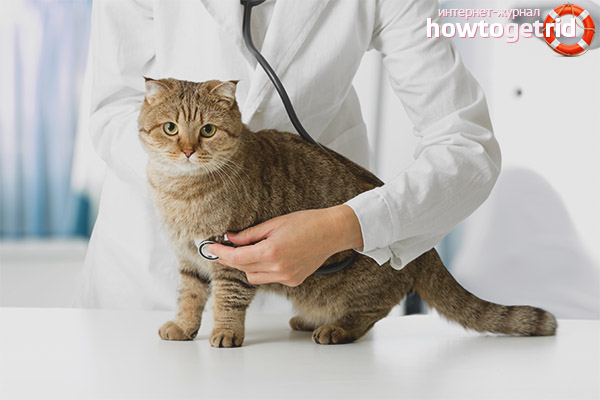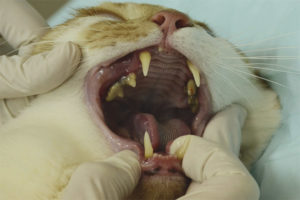The content of the article
Statistics show that about 4 billion of the world's population are infected with parasitic diseases. Such a scale makes us think about preventive measures against parasites. The main sources of human infection are our smaller brothers - including cats.
Often the owner does not suspect that the beloved pet may have parasites until it accidentally finds them in the feces of the animal. The first thing that bothers the owner of the cat in this case is whether it can be the carrier of the same helminths.
How is this dangerous?
Infection with worms is not only unpleasant, but also quite dangerous. The parasite is therefore a parasite because it lives at the expense of others. In the process of their life, they feed on the body of the wearer, leaving him less useful substances necessary for life. In addition, they are able to poison it with the products of their vital activity, which causes intoxication and allergies. The most dangerous consequences of such cohabitation are damage to the organs where the parasites live, and damage to the central nervous system.
A large accumulation of worms in the intestine can cause its obstruction. They often contribute to the development of autoimmune diseases. Often the consequences of the presence of parasites in the body is damage to brain cells, lungs, liver, joints, as well as other organs and systems. Their presence is accompanied by symptoms in the form of a headache, chronic fatigue, as well as disruptions of the digestive tract, constant allergic reactions to food and external irritants.
They have improved this way of existence for thousands of years in the process of evolution. Many types of worms do not even have a mouth; they feed on useful substances from the host organism, absorbing them with the cells of their body. At the moment in the world there are several hundred species. The only place where they cannot live in the human body is hair and nails.
Parasites were, are and will be. They adapt perfectly to any conditions and breed at an amazing rate. Worms are carried, depending on their type, in various ways, including airborne droplets.
Important! Many cat owners mistakenly believe that small kittens cannot be carriers and carriers of worms. Contrary to popular belief, most babies, especially yard children, are infected with parasites at a very early age from their mother, a cat. Infection occurs in utero or during breastfeeding. For this reason, anthelmintic kittens need to, starting with a two-week age.
What kind of parasites do cats have?
In fact, there are a great many of them. At present, three main groups are distinguished in medicine and veterinary medicine:
Roundworms (nematodes)
- Toxocaras. It can be found in cats of all breeds and ages, but usually affects kittens only. There are described cases of infection of people, but they concern children and the elderly. The body of adults who do not have problems with immunity, actively enough to resist infection and destroys those who managed to get inside the larvae.
- Hookworms. In foreign literature, the name Hookworms is usually found - worms, and in Russian literature - the hookworm. So, hookworm is called a disease, as a result of which parasites settle in the small intestine (usually kittens) of the animal in the form of roundworms. Typically, the length of such a helminth is about two or four millimeters, that is, they are barely noticeable.These very hookworms feed on the tissues and blood of a living organism. Through its tooth-shaped hook, the helminth attaches to the walls of the intestine and begins to harm the living organism.
- Roundworm. The worm that affects the body of cats has a white, yellowish tint. These parasitic forms can grow up to twenty centimeters in length. Cats can become infected with these parasitic forms without even leaving home borders. Parasitic eggs can be at home, settling on the owner’s shoes.
- Pinworms. Pinworm infection or enterobiosis is one of the most common parasitic diseases. It is caused by pinworms entering the body. It is transmitted by airborne droplets, so it is very easy to get infected in the home when it comes into contact with the carrier. The main symptom of their presence in humans is itching in the anus. Its cause is the laying of eggs by the female pinworm in the anus, which treats its eggs with a substance called isovaleric acid. This substance irritates the skin, causing the very unpleasant itching.
Flatworms (tapeworms)
- Cucumber tapeworm. It lives in the intestines of the carrier, clinging to its wall with a special hook. It can reach sizes up to 30 cm in length.
- Wide ribbon. May cause vomiting and persistent nausea and cat. Some representatives of this type of worms can reach sizes up to one and a half meters.
- Echinococcus. Type of tape parasites that live in cats. They have a flat body up to 0.5 cm in length. It is difficult to get them from cats, because they are transmitted only by the fecal-oral route. Most often the liver becomes their habitat, where they live and multiply, creating special cavities around themselves. As a result of their life activity, the structure of the organ suffers, and its functions are violated, which inevitably leads to complications in the form of concomitant diseases.
Signs
The owner rarely realizes that the cat suffers from helminthic invasion, without any factual evidence in the form of a “surprise” in the tray. A number of characteristic symptoms that are not direct, but quite characteristic in this situation, can speak of infection with worms:
- The lethargy and drowsiness of the animal.
- Change in taste preferences and the amount of food consumed.
- Pallor and dryness of the mucous membranes.
- Dull hair.
- Violations of the digestive tract. Constipation and diarrhea.
- Large abdominal volume without pregnancy.
- Constant licking of the anus.
- Nausea and vomiting.
- Frequent allergic reactions.
- Dramatic weight loss or weight gain.
Diagnostics

Diagnosis of parasitic diseases in cats is carried out with the participation of a veterinarian in a clinic. To do this, the doctor analyzes the complaints of the owner and examines the medical history. Animal feces are taken for analysis and checked for the presence of waste products and worm eggs in them. Additionally, blood and urine can be taken for analysis. With severe helminthic invasion with accompanying symptoms, a special ultrasound scan of the organs is performed, where the parasite is supposedly inhabited.
Preventative measures
It is worth considering that preventive measures must be observed not only to the owners of the cat, but also to the owners. The main method of prevention is the periodic deworming of both the cats themselves and their owners with the help of special drugs aimed at the destruction of round and tape parasites.
In addition to deworming, the following preventive measures must be observed:
- It must be borne in mind that anthelmintics act only on the inhabitants of the animal’s body, but in no way can destroy the eggs on the surface of the pet’s body.
- Do not give your pet foods that have not undergone sufficient heat treatment.
- All procedures for cleaning cat feces and washing the tray should be accompanied by hand washing using an antibacterial soap.
- The place where the cat's toilet is located and the tray itself should be periodically treated with disinfectants. The same goes for a pet bowl.
- You can’t pick up and pet stray cats. Most often, they are the carriers of parasitic infections.
- A cat living in the house needs to limit contact with animals that have the possibility of free walking.
- With obvious signs of parasite damage to the cat's body, it is necessary to contact a veterinary clinic, where she will be provided with effective, qualified help from a specialist. The veterinarian will prescribe the necessary tests to determine the type of parasite and describe the correct treatment. In addition, the doctor will give recommendations to all family members for treatment and prevention.
Important! Contrary to the belief that worms can be infected from a cat, it is the host that causes parasitic infections of the animal. People bring parasitic eggs on their shoes and clothes, thus infecting themselves and their beloved pet with worms. Especially dangerous in this regard are young children who attend groups and love to dig in the sandbox, eat food without washing their hands before eating, often eat unwashed vegetables and fruits.
Preventive deworming cats
Many people mistakenly believe that a cat who lives in a house cannot be infected with a priori parasites. However, this opinion is erroneous. Pets can pick up helminths through food or socializing with other animals. Most often, it is the owner himself who brings the worms to the house.
In most cases, owners will find out about the presence of parasites in the cat when they see suspicious white dots in the feces, ignoring all the characteristic symptoms that are common before and cannot for certain indicate the presence of a parasitic infection in the body of the animal.
Preventive deworming is carried out to cats quarterly and at least once every six months. Kittens worm away not earlier than when they reach the age of 1 month. During this period, the baby's body manages to get a little stronger. Kittens most often become infected in utero or when breastfeeding.
For deworming cats produced a lot of tools in different forms that are convenient for use: tablets, pastes, suspensions, drops.
Anthelmintic preparations for cats with a wide spectrum of action:
- “Dirofen - paste 20”;
- "Broadline", "Prazicide", "Helmintal" - drops at the withers;
- "Febtal - combo", "Prazitel", "Prazitsid" - suspensions;
- Canikvartel Plus, Febtal, Troncil K, Drontal - tablets.
Preventive human deworming
In rare cases, a modern person reaches a state where characteristic symptoms of the presence of parasitic worms in the body appear. People, like their beloved pets, should ideally have deworming as a preventive measure. For this, a wide range of drugs is used once, about once every six months with a repeat of the procedure after 2 weeks.
Relatively healthy person without obvious signs of helminthic invasion, you can choose your own medicine by contacting a pharmacy.If there are health problems, especially the liver, heart, kidneys and digestive system, then before using medications, you need to visit a doctor and clarify whether such drugs can be used for these pathologies.
Anthelmintic drugs with a wide spectrum of action for people:
- Optisalt;
- Mebendazole
- Levamisole;
- Naftamon and others.
Important! Children under one year of age are dewormed only for special indications and guided by the advice of the attending physician, under his strict supervision.
Video: can a person get worms from a domestic cat or dog










Submit